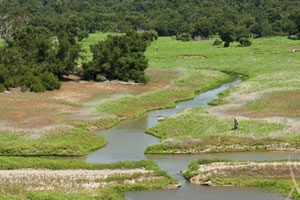ARS is USDA's chief intramural scientific research agency, and this work supports the USDA priority of ensuring food safety.
Even though most strains of E. coli are non-pathogenic, the bacterium is monitored by public health officials as an indicator of water quality. Cows are often seen as the culprits when E. coli is found in local lakes, rivers and other bodies of water.
Ibekwe, who works at the ARS U.S. Salinity Laboratory in Riverside, Calif., and his colleagues collected 450 water and sediment samples from 20 sites throughout California's middle Santa Ana River Watershed. The collection sites included urban areas, livestock feeding areas, parks, National Forest lands, and three wastewater treatment plants.
Then the scientists extracted E. coli bacteria from each sample and identified 600 different isolates of E. coli in their samples, many of which could be placed into six clonal populations. They found the greatest variety of different types of E. coli in runoff discharged from areas dominated by urban development or human activities.
Ibekwe also tested all the E. coli isolates for resistance to various antibiotics. He found that from 88 to 95 percent of the isolates were resistant to rifampicin, and that around 75 percent were resistant to tetracycline. Tetracycline resistance was by far the most common type of resistance observed in E. coli isolates collected near wastewater treatment plants.
The scientists also found that 24 percent of E. coli collected in sediment samples associated with urban runoff—a total of 144 isolates—showed resistance to as many as seven antibiotics. Results from this work were published in PLOS ONE. ![]()
PHOTO CAPTION
A section of the Prado Wetland, part of the vast network of waterways in the Santa Ana River Watershed. ARS microbiologist Mark Ibekwe and his university colleagues sampled 20 sites throughout the watershed for more than a year in a study to determine the origins of Escherichia coli strains. Photo courtesy of USDA-ARS News Service







